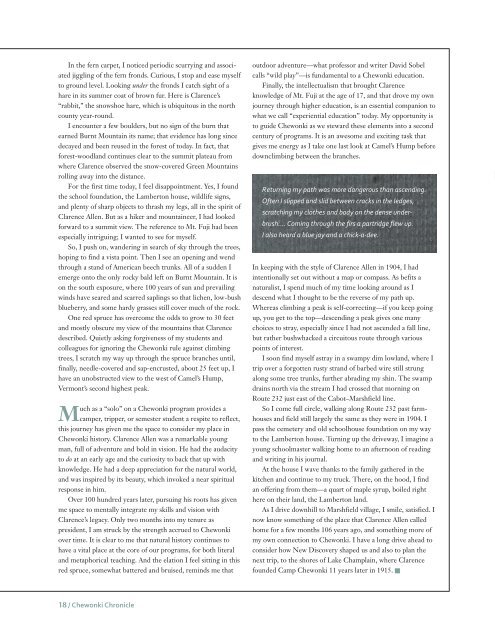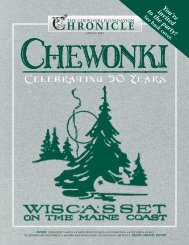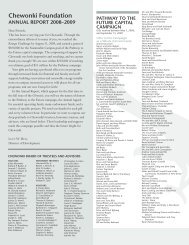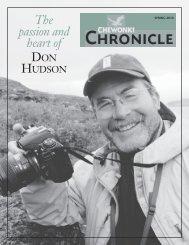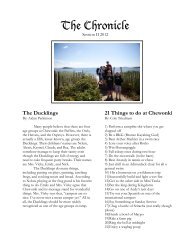Celebrating40Years in the Outdoor Classroom - The Chewonki ...
Celebrating40Years in the Outdoor Classroom - The Chewonki ...
Celebrating40Years in the Outdoor Classroom - The Chewonki ...
Create successful ePaper yourself
Turn your PDF publications into a flip-book with our unique Google optimized e-Paper software.
In <strong>the</strong> fern carpet, I noticed periodic scurry<strong>in</strong>g and associated<br />
jiggl<strong>in</strong>g of <strong>the</strong> fern fronds. Curious, I stop and ease myself<br />
to ground level. Look<strong>in</strong>g under <strong>the</strong> fronds I catch sight of a<br />
hare <strong>in</strong> its summer coat of brown fur. Here is Clarence’s<br />
“rabbit,” <strong>the</strong> snowshoe hare, which is ubiquitous <strong>in</strong> <strong>the</strong> north<br />
county year-round.<br />
I encounter a few boulders, but no sign of <strong>the</strong> burn that<br />
earned Burnt Mounta<strong>in</strong> its name; that evidence has long s<strong>in</strong>ce<br />
decayed and been reused <strong>in</strong> <strong>the</strong> forest of today. In fact, that<br />
forest-woodland cont<strong>in</strong>ues clear to <strong>the</strong> summit plateau from<br />
where Clarence observed <strong>the</strong> snow-covered Green Mounta<strong>in</strong>s<br />
roll<strong>in</strong>g away <strong>in</strong>to <strong>the</strong> distance.<br />
For <strong>the</strong> first time today, I feel disappo<strong>in</strong>tment. Yes, I found<br />
<strong>the</strong> school foundation, <strong>the</strong> Lamberton house, wildlife signs,<br />
and plenty of sharp objects to thrash my legs, all <strong>in</strong> <strong>the</strong> spirit of<br />
Clarence Allen. But as a hiker and mounta<strong>in</strong>eer, I had looked<br />
forward to a summit view. <strong>The</strong> reference to Mt. Fuji had been<br />
especially <strong>in</strong>trigu<strong>in</strong>g; I wanted to see for myself.<br />
So, I push on, wander<strong>in</strong>g <strong>in</strong> search of sky through <strong>the</strong> trees,<br />
hop<strong>in</strong>g to f<strong>in</strong>d a vista po<strong>in</strong>t. <strong>The</strong>n I see an open<strong>in</strong>g and wend<br />
through a stand of American beech trunks. All of a sudden I<br />
emerge onto <strong>the</strong> only rocky bald left on Burnt Mounta<strong>in</strong>. It is<br />
on <strong>the</strong> south exposure, where 100 years of sun and prevail<strong>in</strong>g<br />
w<strong>in</strong>ds have seared and scarred sapl<strong>in</strong>gs so that lichen, low-bush<br />
blueberry, and some hardy grasses still cover much of <strong>the</strong> rock.<br />
One red spruce has overcome <strong>the</strong> odds to grow to 30 feet<br />
and mostly obscure my view of <strong>the</strong> mounta<strong>in</strong>s that Clarence<br />
described. Quietly ask<strong>in</strong>g forgiveness of my students and<br />
colleagues for ignor<strong>in</strong>g <strong>the</strong> <strong>Chewonki</strong> rule aga<strong>in</strong>st climb<strong>in</strong>g<br />
trees, I scratch my way up through <strong>the</strong> spruce branches until,<br />
f<strong>in</strong>ally, needle-covered and sap-encrusted, about 25 feet up, I<br />
have an unobstructed view to <strong>the</strong> west of Camel’s Hump,<br />
Vermont’s second highest peak.<br />
Much as a “solo” on a <strong>Chewonki</strong> program provides a<br />
camper, tripper, or semester student a respite to reflect,<br />
this journey has given me <strong>the</strong> space to consider my place <strong>in</strong><br />
<strong>Chewonki</strong> history. Clarence Allen was a remarkable young<br />
man, full of adventure and bold <strong>in</strong> vision. He had <strong>the</strong> audacity<br />
to do at an early age and <strong>the</strong> curiosity to back that up with<br />
knowledge. He had a deep appreciation for <strong>the</strong> natural world,<br />
and was <strong>in</strong>spired by its beauty, which <strong>in</strong>voked a near spiritual<br />
response <strong>in</strong> him.<br />
Over 100 hundred years later, pursu<strong>in</strong>g his roots has given<br />
me space to mentally <strong>in</strong>tegrate my skills and vision with<br />
Clarence’s legacy. Only two months <strong>in</strong>to my tenure as<br />
president, I am struck by <strong>the</strong> strength accrued to <strong>Chewonki</strong><br />
over time. It is clear to me that natural history cont<strong>in</strong>ues to<br />
have a vital place at <strong>the</strong> core of our programs, for both literal<br />
and metaphorical teach<strong>in</strong>g. And <strong>the</strong> elation I feel sitt<strong>in</strong>g <strong>in</strong> this<br />
red spruce, somewhat battered and bruised, rem<strong>in</strong>ds me that<br />
18 / <strong>Chewonki</strong> Chronicle<br />
outdoor adventure—what professor and writer David Sobel<br />
calls “wild play”—is fundamental to a <strong>Chewonki</strong> education.<br />
F<strong>in</strong>ally, <strong>the</strong> <strong>in</strong>tellectualism that brought Clarence<br />
knowledge of Mt. Fuji at <strong>the</strong> age of 17, and that drove my own<br />
journey through higher education, is an essential companion to<br />
what we call “experiential education” today. My opportunity is<br />
to guide <strong>Chewonki</strong> as we steward <strong>the</strong>se elements <strong>in</strong>to a second<br />
century of programs. It is an awesome and excit<strong>in</strong>g task that<br />
gives me energy as I take one last look at Camel’s Hump before<br />
downclimb<strong>in</strong>g between <strong>the</strong> branches.<br />
Return<strong>in</strong>g my path was more dangerous than ascend<strong>in</strong>g.<br />
Often I slipped and slid between cracks <strong>in</strong> <strong>the</strong> ledges,<br />
scratch<strong>in</strong>g my clo<strong>the</strong>s and body on <strong>the</strong> dense underbrush….<br />
Com<strong>in</strong>g through <strong>the</strong> firs a partridge flew up.<br />
I also heard a blue jay and a chick-a-dee.<br />
In keep<strong>in</strong>g with <strong>the</strong> style of Clarence Allen <strong>in</strong> 1904, I had<br />
<strong>in</strong>tentionally set out without a map or compass. As befits a<br />
naturalist, I spend much of my time look<strong>in</strong>g around as I<br />
descend what I thought to be <strong>the</strong> reverse of my path up.<br />
Whereas climb<strong>in</strong>g a peak is self-correct<strong>in</strong>g—if you keep go<strong>in</strong>g<br />
up, you get to <strong>the</strong> top—descend<strong>in</strong>g a peak gives one many<br />
choices to stray, especially s<strong>in</strong>ce I had not ascended a fall l<strong>in</strong>e,<br />
but ra<strong>the</strong>r bushwhacked a circuitous route through various<br />
po<strong>in</strong>ts of <strong>in</strong>terest.<br />
I soon f<strong>in</strong>d myself astray <strong>in</strong> a swampy dim lowland, where I<br />
trip over a forgotten rusty strand of barbed wire still strung<br />
along some tree trunks, fur<strong>the</strong>r abrad<strong>in</strong>g my sh<strong>in</strong>. <strong>The</strong> swamp<br />
dra<strong>in</strong>s north via <strong>the</strong> stream I had crossed that morn<strong>in</strong>g on<br />
Route 232 just east of <strong>the</strong> Cabot–Marshfield l<strong>in</strong>e.<br />
So I come full circle, walk<strong>in</strong>g along Route 232 past farmhouses<br />
and field still largely <strong>the</strong> same as <strong>the</strong>y were <strong>in</strong> 1904. I<br />
pass <strong>the</strong> cemetery and old schoolhouse foundation on my way<br />
to <strong>the</strong> Lamberton house. Turn<strong>in</strong>g up <strong>the</strong> driveway, I imag<strong>in</strong>e a<br />
young schoolmaster walk<strong>in</strong>g home to an afternoon of read<strong>in</strong>g<br />
and writ<strong>in</strong>g <strong>in</strong> his journal.<br />
At <strong>the</strong> house I wave thanks to <strong>the</strong> family ga<strong>the</strong>red <strong>in</strong> <strong>the</strong><br />
kitchen and cont<strong>in</strong>ue to my truck. <strong>The</strong>re, on <strong>the</strong> hood, I f<strong>in</strong>d<br />
an offer<strong>in</strong>g from <strong>the</strong>m—a quart of maple syrup, boiled right<br />
here on <strong>the</strong>ir land, <strong>the</strong> Lamberton land.<br />
As I drive downhill to Marshfield village, I smile, satisfied. I<br />
now know someth<strong>in</strong>g of <strong>the</strong> place that Clarence Allen called<br />
home for a few months 106 years ago, and someth<strong>in</strong>g more of<br />
my own connection to <strong>Chewonki</strong>. I have a long drive ahead to<br />
consider how New Discovery shaped us and also to plan <strong>the</strong><br />
next trip, to <strong>the</strong> shores of Lake Champla<strong>in</strong>, where Clarence<br />
founded Camp <strong>Chewonki</strong> 11 years later <strong>in</strong> 1915. ■


